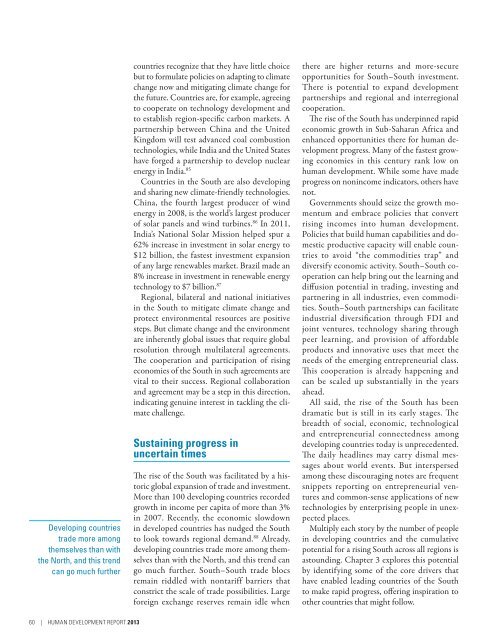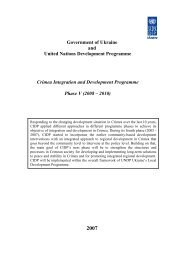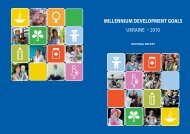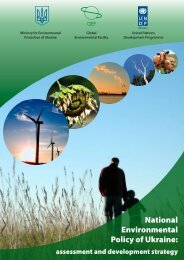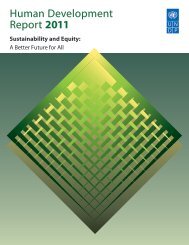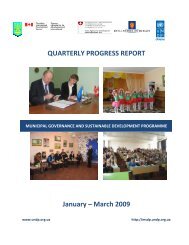E N S W - United Nations Development Programme
E N S W - United Nations Development Programme
E N S W - United Nations Development Programme
You also want an ePaper? Increase the reach of your titles
YUMPU automatically turns print PDFs into web optimized ePapers that Google loves.
developing countries<br />
trade more among<br />
themselves than with<br />
the North, and this trend<br />
can go much further<br />
countries recognize that they have little choice<br />
but to formulate policies on adapting to climate<br />
change now and mitigating climate change for<br />
the future. Countries are, for example, agreeing<br />
to cooperate on technology development and<br />
to establish region-specific carbon markets. A<br />
partnership between China and the <strong>United</strong><br />
Kingdom will test advanced coal combustion<br />
technologies, while India and the <strong>United</strong> States<br />
have forged a partnership to develop nuclear<br />
energy in India. 85<br />
Countries in the South are also developing<br />
and sharing new climate-friendly technologies.<br />
China, the fourth largest producer of wind<br />
energy in 2008, is the world’s largest producer<br />
of solar panels and wind turbines. 86 In 2011,<br />
India’s National Solar Mission helped spur a<br />
62% increase in investment in solar energy to<br />
$12 billion, the fastest investment expansion<br />
of any large renewables market. Brazil made an<br />
8% increase in investment in renewable energy<br />
technology to $7 billion. 87<br />
Regional, bilateral and national initiatives<br />
in the South to mitigate climate change and<br />
protect environmental resources are positive<br />
steps. But climate change and the environment<br />
are inherently global issues that require global<br />
resolution through multilateral agreements.<br />
The cooperation and participation of rising<br />
economies of the South in such agreements are<br />
vital to their success. Regional collaboration<br />
and agreement may be a step in this direction,<br />
indicating genuine interest in tackling the climate<br />
challenge.<br />
Sustaining progress in<br />
uncertain times<br />
The rise of the South was facilitated by a historic<br />
global expansion of trade and investment.<br />
More than 100 developing countries recorded<br />
growth in income per capita of more than 3%<br />
in 2007. Recently, the economic slowdown<br />
in developed countries has nudged the South<br />
to look towards regional demand. 88 Already,<br />
developing countries trade more among themselves<br />
than with the North, and this trend can<br />
go much further. South–South trade blocs<br />
remain riddled with nontariff barriers that<br />
constrict the scale of trade possibilities. Large<br />
foreign exchange reserves remain idle when<br />
there are higher returns and more- secure<br />
opportunities for South–South investment.<br />
There is potential to expand development<br />
partnerships and regional and interregional<br />
cooperation.<br />
The rise of the South has underpinned rapid<br />
economic growth in Sub-Saharan Africa and<br />
enhanced opportunities there for human development<br />
progress. Many of the fastest growing<br />
economies in this century rank low on<br />
human development. While some have made<br />
progress on nonincome indicators, others have<br />
not.<br />
Governments should seize the growth momentum<br />
and embrace policies that convert<br />
rising incomes into human development.<br />
Policies that build human capabilities and domestic<br />
productive capacity will enable countries<br />
to avoid “the commodities trap” and<br />
diversify economic activity. South–South cooperation<br />
can help bring out the learning and<br />
diffusion potential in trading, investing and<br />
partnering in all industries, even commodities.<br />
South–South partnerships can facilitate<br />
industrial diversification through FDI and<br />
joint ventures, technology sharing through<br />
peer learning, and provision of affordable<br />
products and innovative uses that meet the<br />
needs of the emerging entrepreneurial class.<br />
This cooperation is already happening and<br />
can be scaled up substantially in the years<br />
ahead.<br />
All said, the rise of the South has been<br />
dramatic but is still in its early stages. The<br />
breadth of social, economic, technological<br />
and entrepreneurial connectedness among<br />
developing countries today is unprecedented.<br />
The daily headlines may carry dismal messages<br />
about world events. But interspersed<br />
among these discouraging notes are frequent<br />
snippets reporting on entrepreneurial ventures<br />
and common-sense applications of new<br />
technologies by enterprising people in unexpected<br />
places.<br />
Multiply each story by the number of people<br />
in developing countries and the cumulative<br />
potential for a rising South across all regions is<br />
astounding. Chapter 3 explores this potential<br />
by identifying some of the core drivers that<br />
have enabled leading countries of the South<br />
to make rapid progress, offering inspiration to<br />
other countries that might follow.<br />
60 | HUMAN DevELOPMENT REPORT 2013


